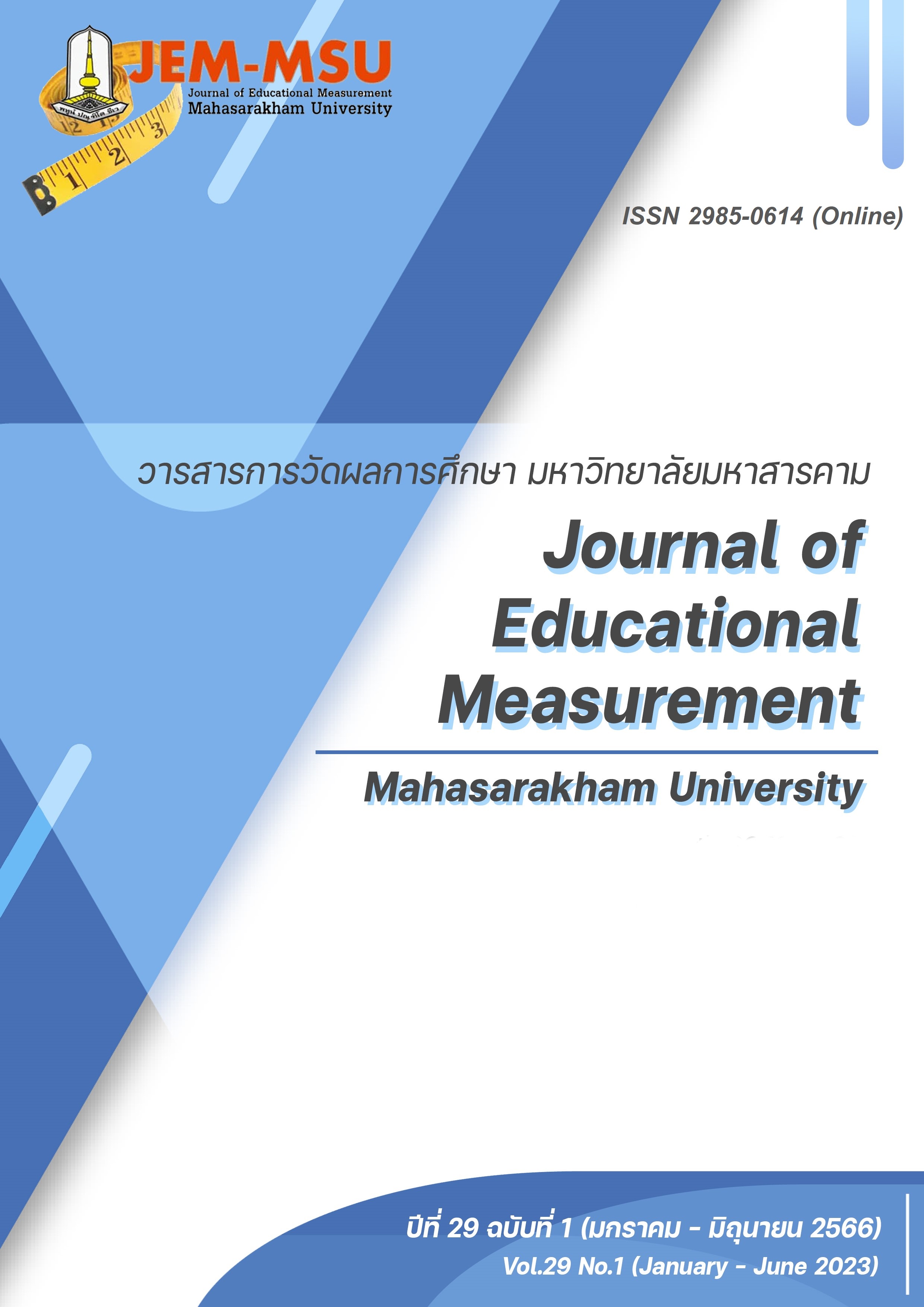การออกแบบวิธีการวินิจฉัยมโนทัศน์ที่คลาดเคลื่อนทางวิทยาศาสตร์ โดยการให้ข้อมูลป้อนกลับแบบอัตโนมัติผ่านการเรียนรู้ของเครื่อง
Main Article Content
บทคัดย่อ
การวิจัยครั้งนี้มีความมุ่งหมาย (1) เพื่อวิเคราะห์ผลการตอบของผู้เรียนในระดับแผนที่โครงสร้างมโนทัศน์ที่คลาดเคลื่อน การออกแบบตัวเลือกแบบเลือกตอบ การกำหนดจุดตัด และข้อมูลพื้นฐานที่ใช้ในการทำนายระดับความสามารถของผู้เรียน และ (2) เพื่อออกแบบวิธีการวินิจฉัยมโนทัศน์ที่คลาดเคลื่อนทางวิทยาศาสตร์ของผู้เรียน จากการให้ข้อมูลป้อนกลับอัตโนมัติผ่านการเรียนรู้ของเครื่องโดยใช้การวิจัยการออกแบบ กลุ่มผู้สอบ คือผู้เรียนระดับชั้นมัธยมศึกษาปีที่ 4 จำนวน 713 คน ใช้แบบทดสอบวินิจฉัยมโนทัศน์ ที่คลาดเคลื่อนทางวิทยาศาสตร์แบบพหุมิติ ประกอบด้วยมิติความรู้และมิติการให้เหตุผลโดยใช้โมเดล MRCMLวิเคราะห์ผลการตอบของผู้เรียน และออกแบบวิธีการวินิจฉัยมโนทัศน์ที่คลาดเคลื่อนทางวิทยาศาสตร์
ผลการวิจัยปรากฏ ดังนี้
1. ผลการวิเคราะห์ผลการตอบของผู้เรียน พบว่า (1) ระดับความสามารถของข้อสอบตามแผนที่โครงสร้างสามารถวัดระดับความสามารถของผู้เรียนได้ตามระดับแผนที่โครงสร้าง และ มีบางข้อที่ผู้เรียนมีความสามารถเกินความสามารถรายข้อที่กำหนดไว้ (2) ผู้เรียนส่วนมากมีรูปแบบมโนทัศน์ที่คลาดเคลื่อนรายข้อในรูปแบบความเข้าใจผิดเกี่ยวกับมโนทัศน์และภาษา และทั้งฉบับในมิติด้านความรู้ในระดับความไม่เข้าใจ และมิติการให้เหตุผลในระดับที่ถูกต้องแต่ไม่สมบูรณ์ (3) ออกแบบตัวเลือกแบบเลือกตอบจากคำตอบของผู้เรียน โดยตัวเลือกมีคะแนนหลายค่าตามระดับความสามารถของตัวเลือก (4) กำหนดจุดตัดโดยการกำหนดพื้นที่บน Wright map ในมิติความรู้ได้ 5 ระดับ 4 จุดตัดที่ -0.50 0.50 0.42 และ 1.19 ตามลำดับ และมิติการให้เหตุผลได้ 4 ระดับ 3 จุดตัดที่ -0.19 2.29 และ 5.49 ตามลำดับ และ (5) ข้อมูลพื้นฐานที่สามารถทำนายระดับความสามารถของผู้เรียนได้ คือ เกรดเฉลี่ยรวม เกรดเฉลี่ยวิชาวิทยาศาสตร์ และจำนวนชั่วโมงที่ศึกษาวิชาวิทยาศาสตร์
2. ผลการออกแบบวิธีการวินิจฉัยมโนทัศน์ที่คลาดเคลื่อนทางวิทยาศาสตร์ โดยการให้ข้อมูลป้อนกลับอัตโนมัติผ่านการเรียนรู้ของเครื่องประกอบด้วย 4 ส่วน คือ (1) ส่วนรับข้อมูล (2) ส่วนประมวลผล (3) การให้ข้อมูลป้อนกลับอัตโนมัติ และ (4) ส่วนรายงานผลการประเมิน
Article Details

This work is licensed under a Creative Commons Attribution-NonCommercial-NoDerivatives 4.0 International License.
เนื้อหาและข้อมูลในบทความที่ลงตีพิมพ์ในวารสารการวัดผลการศึกษา มหาวิทยาลัยมหาสารคาม ถือเป็นข้อคิดเห็นและความรับผิดชอบของผู้เขียนบทความโดยตรง ซึ่งกองบรรณาธิการวารสาร ไม่จำเป็นต้องเห็นด้วย หรือร่วมรับผิดชอบใดๆ
บทความ ข้อมูล เนื้อหา รูปภาพ ฯลฯ ที่ได้รับการตีพิมพ์ในวารสารการวัดผลการศึกษา มหาวิทยาลัยมหาสารคาม ถือเป็นลิขสิทธิ์ของวารสารการวัดผลการศึกษา มหาวิทยาลัยมหาสารคาม หากบุคคลหรือหน่วยงานใดต้องการนำทั้งหมดหรือส่วนใดส่วนหนึ่งไปเผยแพร่ต่อหรือกระทำการใดๆ จะต้องได้รับอนุญาตเป็นลายลักษณ์อักษรจากวารสารการวัดผลการศึกษา มหาวิทยาลัยมหาสารคาม ก่อนเท่านั้น
References
American Educational Research Association, American Psychological Association & National Council on Measurement in Education. (2014). Standards for Educational and Psychological Testing.Standards for Educational and Psychological Testing. The American Educational Research Association
Adams, R.J., Wilson, M., & Wang, W.C. (1997). The multidimensional random coefficients multinomial logic model. Applied Psychological Measurement, 21(1), 1-23.
Gadzella, B. M., Baloglu, M., & Stephens, R. (2002). Prediction of GPA with Educational psychology grades and critical thinking scores. Project Innovation (Alabama), 122(3), 618-623.
Gouli, E., Gogoulou, A., & Grigoriadou, M. (2008). Supporting Self- Peer- and Collaborative-Assessment in E-Learning: The Case of the PEer and Collaborative ASSessment Environment (PECASSE). Journal of Interactive Learning Research, 19(4), 615-647.
Gurel, K. G, Eryılmaz, A., & McDermott, L. C. (2015). A Review and Comparison of Diagnostic Instruments to Identify Students’ Misconceptionss in Science. Eurasia Journal of Mathematics. Science & Technology Education, 11(5). https://doi.org/10.12973/eurasia.2015.1369a
Kantahan, S., Junpeng, P., Punturat, S., Tang,K. N., P. Gochyyev., & Wilson, M. (2020).Designing and verifying a tool for diagnosing multidimensional scientific misconceptions in genetics topic. International Journal of Evaluation and Research in Education, 9(3), 564-571. https:// doi.org/10.11591/ijere.v9i3.20544
Kalas, P., O’Neill. A., Pollock, C., & Birol, G. (2013). Development of a meiosis concept inventory. CBE Life Sciences Education, 12(4), 655–664.https://doi.org/10.1187/cbe.12-10-0174
Ling, T.W. (2017). Fostering Understanding and Reducing Misconceptions about Image Formation by a Plane Mirror Using Constructivist-Based Hands-On Activities. Springer.
Mitchell, T. M. (1997). Does Machine Learning Really Work?. AI Magazine, 18(3), 11. https://doi.org/10.1609/aimag.v18i3.1303
Mohammed, M., Khan, M.B., and Bashier, E.B.M. (2016). Machine learning: algorithms and applications. CRC Press. https://doi.org/10.1201/9781315371658
Nafea, I. (2018). Machine Learning in Educational Technology. Machine Learning – Advanced Techniques and Emerging Applications, 175-183. https://doi.org /10.5772/intechopen.72906
National Research Council. (1997). Science teaching reconsidered. National Academies Press.
Paneaw, S., Junpeng, P., & Tang, K. N. (2021). Designing Standards-Setting for Levels of Mathematical Proficiency in Measurement and Geometry: Multidimensional Item Response Model. Journal of Education and Learning, 10(6), 103-111. https://doi.org/10.5539/jel.v10n6p103
Soeharto, S., Csapó, B., Sarimanah, E., Dewi, F.I., and Sabri, T. (2019). A Review of Students’ Common Misconceptionss in Science and Their Diagnostic Assessment Tools. Journal Pendidikan IPA Indonesia, 8(2), 247-266. https://doi.org/10.15294/jpii.v8i2.18649
Westbrook, S. L., & Marek, E. A. (1992). “A cross-age study of student understanding of the concept of diffusion”. Journal of Research in Science Teaching, 29(1), 51-61.
Widiyatmoko, A., & Shimizu, K. (2018). Literature Review of Factors Contributing to Students’ Misconceptions in Light and Optical Instruments. International Journal of Environmental and Science Education, 13(10), 853-863.
Wilson, M. (2005). Constructing measures: An item response modeling approach. Evaluation and Program Planning, 28(4), 433-434. https://doi.org/10.1016/j.evalprogplan.2005.07.008
Wu, M. L., Adams, R. J., & Wilson, M. R. (2007). ACER Conquest: Generalized item response modelling software. ACER.
Wu, J. Y., Hsiao, Y. C., & Nian, M. W. (2018). Using supervised machine learning on large-scale online forums to classify course-related Facebook messages in predicting learning achievement within the personal learning environment. Interactive Learning Environments, 28(1), 1-16. https://doi.org/10.1080/10494820.2018.1515085
Yarbrough, D. B., Shulha, L. M., Hopson, R. K., & Caruthers, F. A. (2010). The program Evaluation standards: A guide for evaluators and evaluation users (3rd Ed.). Sage.
Zhang, F., Zhang, X., Luo, M., & Geng, H. (2016). The Effects of Feedback on Memory Strategies of Younger and Older Adults. PLOS ONE. https://doi.org/10.1371/journal.pone.0168896
Junpeng, P. (2018). Application of Multidimensional Item Response Theory to Research. Khon Kaen University Press. (in Thai)
Junpeng, P., Marwiang, M., Chinjunthuk, S., Suwannatrai, P., Grotha, J., Chanayotha, K., Tawarungruang, C., Thuanman, J., Ngang, T.K., & Wilson, M. R. (2020). Developing Students’ Mathematical Proficiency Level Diagnostic Tools through Information Technology in Assessment for Learning Report. Thailand Science Research and Innovation. (in Thai)
Kantahan, S. (2020). Designing and verifying a tool for diagnosing multidimensional scientific misconceptionss in genetics topic [Master’s thesis]. Khon Kaen University (in Thai)
Kerdkliang, S., Intasuwan, S., & Wannasuth, N. (2019). Effect of Inquiry Learning Cycle (7E) and Jigsaw Technique on Plants Reproduction and Development Topic to Develop Biological Learning Achievement and Social Skill for Mattayomseuksa 5 Student. Research and Innovation for Sustainability Development, 29(29), 1943-1950. (in Thai)
Masantiah, J. (2017). Development of A Computer-Based Testing System with Immediate Feedback for Different Student’s Ability Levels: Application of Rasch Sirt Model [Master’s thesis]. Chulalongkorn University. (in Thai)
Paneaw, S. (2021). Standard Setting of Mathematical Proficiency Level for the Mixed Format Test through Digital Technology [Master’s thesis]. Khon Kaen University. (in Thai)
Thakho, P., & Termtachatipongsa, P. (2015). The Development of Grade 11 Students’ Conception of Photosynthesis using Inquiry-Based Approach Associated with Scaffolding Strategies. Journal of Education Khon Kaen University, 38(3), 94-104. (in Thai)
Varasunun, P. (2011). The Program Evaluation Standards (3rd Ed.) in 2010. Journal of Research Methodology, 24(2), 273-278. (in Thai)
Wongwanich, S. (2017). Design Research in Education. Chulalongkorn University Press. (in Thai)

